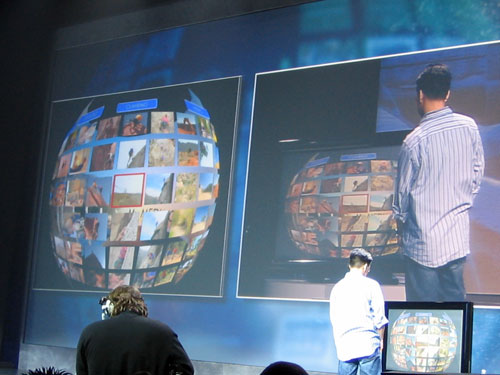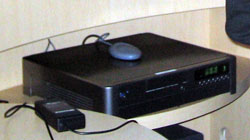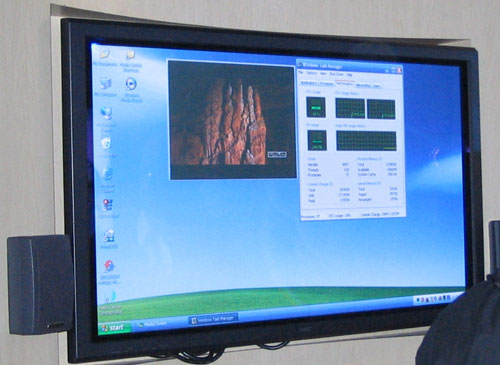Consumer Electronics Show 2005: AT's Coverage
by Anand Lal Shimpi on January 10, 2005 3:49 AM EST- Posted in
- Trade Shows
Dual Core at 3.0GHz - Working Now
Starting off with the PC side of things, Intel was far more present at CES than AMD, which is what we expected given the higher level of involvement from Intel on the CE front.
During Craig Barrett's keynote on the first day of CES, one of the demos involved a media center PC (not MCE) showcasing an interesting method of navigating video content on the PC: using hand gestures.

The spherical image on the left was basically your channel listing, with each one of those little windows displaying a full frame rate video stream, the sum of which was all of the channels you could possibly watch. You could rotate the channels left or right by moving your hands in the appropriate direction, and you could select which channel you wanted to watch by pointing at it. The demo wasn't flawless but Barrett promised that the technology being demoed was something that would be available 12 months from now.
Whether he was talking about every aspect of that particular PC or just its dual core Smithfield based processor is up to anyone's speculation. Unfortunately Barrett didn't disclose too much about the CPU specs of the system other than it was a dual core unit.

Intel's Dual Core Smithfield Pentium 4 x30 platform with both cores running at 3.0GHz
Luckily at Intel's booth we were able to get a glimpse of said system and found out it was a fully functional 90nm Smithfield running at 3.0GHz. It's about time Intel had a running dual core demo, it was beginning to look like only AMD would be able to pull off dual core.

Task Manager shows the two cores in action, note that there is no Hyper Threading on Dual Core CPUs so there are only two physical CPUs listed
Bring up of Intel's dual core seems to be pretty strong and everything is on track for a release at the end of 2005. We did get confirmation that the dual core CPUs would not work on existing 925X and 915 based motherboards, not without changes to their design. While we would normally be disappointed, the fact of the matter is that very few people bought 925X and 915 based motherboards so it's not too big of a deal.
We also asked Intel if they had any tricks up their sleeve for regaining the definitive performance crown this year - unfortunately their answer was no. It appears that a lot of upper management at Intel is a bit astounded by the success of Centrino, noting that it is a full blown success achieved on features and a full platform and not purely performance. There's also this idea that performance right now is good enough for most desktop users, and fighting over a handful of percentage points that won't be appreciated is a silly battle to win. So for the near future at least, it seems like what we've published in previous Intel roadmaps is all we're going to see from them. What remains to be seen is if AMD will be able to continue to convert Intel's lack of focus on absolute performance leadership into marketshare for AMD.
Intel also seems confident that dual core will bring noticeable performance gains to the desktop user, citing that while application support may not be there that the OS and multitasking experiences will be greatly improved to the point that once you've used dual core you'll never go back. Having personally used multiprocessor systems as my main workstations for years now I can attest to the benefits of multiprocessors, however more than anything we're going to need a good way of quantifying the performance benefits with something else than an Intel script that runs an antivirus scan while you defragment your hard drive.










48 Comments
View All Comments
dderidex - Monday, January 10, 2005 - link
About that SN25P....nice Envy24 chip on it - but do we know anything about the DAC used?24/192 internal precision is useless if they pair it with a 16/48 DAC. If their was a Wolfson chip on that motherboard by the Envy24 chip...I would be *drooling*.
Reflex - Monday, January 10, 2005 - link
#36: I am not debating that. I am saying that you need to pay attention to his statement about 'a way that you won't expect'. For one, it won't be a nVidia developed solution. That I can guarantee you since there is NO DESIGN TEAM anymore. But you can choose to believe what you wish I suppose....shinotenshi - Monday, January 10, 2005 - link
SAN JOSE — Here at NVIDIA's Editor's Day event today, NVIDIA CEO Jen-Hsun Huang addressed questions about the company's plans for a possible second spin of its popular but ill-fated SoundStorm audio solution. Apparently, a reprise of SoundStorm will happen. Huang told the assembled press types, "We're gonna build SoundStorm 2. It's gonna be awesome." He was less clear on what form the next SoundStorm would take, saying that NVIDIA was still trying to figure out how to deliver SoundStorm as a product. Huang said, cryptically, that the new SoundStorm "will come in a way that you won't expectshabby - Monday, January 10, 2005 - link
14: the way our living room is arranged we needed a display that allowed viewing from an angle and needed to be thin, and this is where the dlp fell flat on its face. It was too dark and too thick, at least compared to a plasma.While plasma's do wear out over time, thraxes just proved that it takes a long long time.
Reflex - Monday, January 10, 2005 - link
SoundStorm is completely dead. The group is disbanded and its members have found jobs in other parts of the company. This is a fact.Sound in nVidia's chipset solutions is not dead, however. From what I have heard though its just a license of Intel's Azalia spec. In other words: No different than the integrated sound that you get on any Intel chipset board nowadays.
The SoundStorm solution that you all know from the NF/NF2 days is completely gone however, and it will NOT be making a comeback.
shinotenshi - Monday, January 10, 2005 - link
Well As i said, as being part of chipset its dead. but nvidia knows it can make a killing makeing add in sound boards. creative makes weak products let get real. The orginal soundstorm needed too much bandwidth to be done on pci. with PCI-E they have enough bandwidth to produce the card. Nvidia will be able to fund SS2 development becuase of its deal with the Ps3. The PS3 will need a high end sound chip because im sure sony is going to use it as means of spreading blu-ray introduction.bob661 - Monday, January 10, 2005 - link
I think the CEO of Nvidia is just trying to keep customers. He would lose a few by announcing that SS is totally dead. I would string you guys along until it didn't make a difference whether you bailed or not.bob661 - Monday, January 10, 2005 - link
The Inq isn't lying. They are reporting what's been told to them. That's they're job. Sometimes it's bum info.knitecrow - Monday, January 10, 2005 - link
On the soundstorm issue, I personally wouldn't believe AMD, Intel, Nvidia, or ATI... they have been known to lie when it suits their interests.**cough** 6800GT/ultra hardware mpeg2/WMV decoding **cough**
There are conflicting reports to be sure, but I am more likey to believe those from close partners. I am sure the next soundstorm is going to be an intel azilla rehash to appease the masses.
shinotenshi - Monday, January 10, 2005 - link
Soundstorm is not dead, the chairman of nvidia confirm this himself. however i think its dead as far as being apart of a chipset. the chairman remarked that it would return in a suprising form.this has to the belief that either it will return as a seperate chip sutitable for add in sound boards, or interagrated in graphics cards. my bet is that it will return as a PCI-e card capable of encoding some the advance audio codecs that are apart of the blu-ray spec. I don't think it was a coincidence that the chairman of nvidia made the announcement shortly after it was revealed that nvidia would be doing the PS3's GPU.